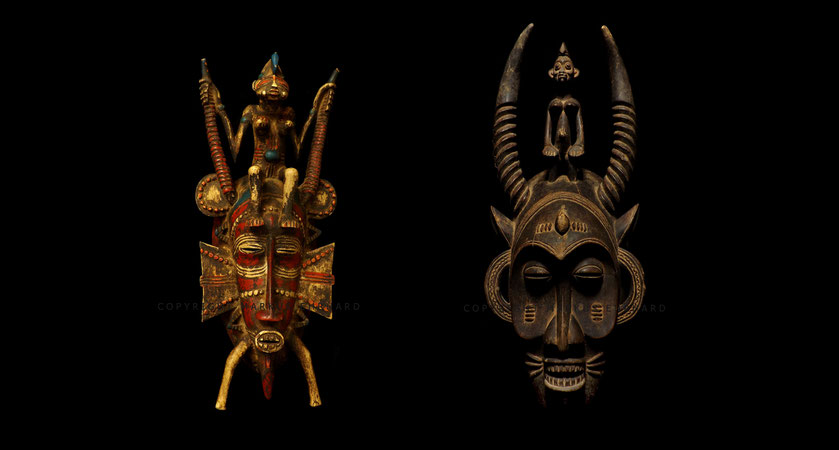
Upfront: I have no final explanation or committed description of this certain genre. Over the years of collecting Kpelié masks, I observed the characteristica of a center top placed Tugubele (I persume it is a Tugubele spirit), that in most cases holds long horns. Mostly the horns are ripped and sometimes twisted. I assume that these horns belong to a kind of antilope, because shape and structure are different to a caddle or buffalo of the Senufo. The Kpelié by Bakari Coulibaly has in addition two ears below the horns.
It is quite obvious, that the faces of this genre are diverse to the classic face of the Kpelié. In case of the mask carved by Bakari Coulibaly, I would not have had the idea, that this is a Kpelié. The Kpelié made by Ziehouo Coulibaly is closer to the classic Kpelié, but he differentiated also in the elongated silhouette and in a face with a very spiky chin. Ziehouo also carved the spirit on top holding the horns with his big hands. Accentuate this scenery it is for sure, that this is a symbol for something. I persume it should show the power of a spirit over animals or a kind of a hunting scene.
There is the association of the Nokârigâh known. They are a kind of healer and omniscient observer. As a symbol the Nokârigâh wear a ring with a buffalo head, which is different to the design a features of these masks. I never received an answer or closer information about this special genre.
Left: Kpelié mask, carved by Ziehouo Coulibaly, Koulé from Korhogo.
37,0x 16,5 x 8,5 cm, wood and paint.
Literature:
- Wenn Neuordnung Ordnung schafft, Markus Ehrhard, pages 170 - 173.
Right: Kpelié mask, carved by Bakari Coulibaly, Koulé from Dickodougou. 37,5 x 15,0 x 11,0 cm, wood.
Literature:
- Wenn Urform Form bestimmt, Markus Ehrhard, pages 156 - 159.
Copyright content and images by Markus Ehrhard

